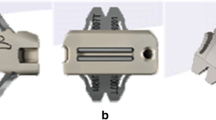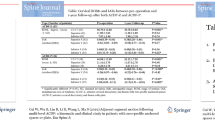Abstract
Purpose
To evaluate changes in the sagittal parameters of the occipito-atlantoaxial complex after three-level anterior cervical decompression and fusion (ACDF) and identify the influential factors by comparing ACDF with a zero-profile anchored spacer (ACDF-Z) versus a cage-plate construct (ACDF-P).
Methods
The cohort comprised 106 patients who underwent three-level contiguous ACDF-Z or ACDF-P for cervical radiculopathy and/or myelopathy. Standing, flexion, and extension radiographs of cervical spine were obtained preoperatively, and 3 and 12 months postoperatively. The assessed cervical sagittal parameters were the platform angle of the axis, Cobb angle, and range of motion (ROM) of C2⁃7, C0⁃1, and C1⁃2.
Results
In both the ACDF-Z and ACDF-P groups, the Cobb angle of the upper cervical spine decreased and the C0-1 ROM increased from preoperatively to 3 and 12 months postoperatively (P < 0.01). The alignment restoration was lost at 12 months compared with 3 months in the ACDF-Z group, but not in the ACDF-P group (P < 0.01). The ACDF-P group showed more loss of C2-7 ROM and more compensatory changes in C0-2 ROM than the ACDF-Z group (P < 0.05).
Conclusion
The Cobb angle decreased and ROM increased significantly as compensatory changes of the atlantooccipital or atlantoaxial joint after both types of ACDF, which may accelerate degeneration. The zero-profile anchored spacer had less impact on the occipito-atlantoaxial complex but was worse at maintaining the alignment restoration, which were contrary to the cage-plate construct. Surgeons should be aware of the impact of multi-level ACDFs on the occipito-atlantoaxial complex.




Similar content being viewed by others
References
Ct K, Levin LS, Ondra SL, Shaffrey CI, Morgan CJ (2007) Neutral upright sagittal spinal alignment from the occiput to the pelvis in asymptomatic adults: a review and resynthesis of the literature. J Neurosurg Spine 6:104–112. https://doi.org/10.3171/spi.2007.6.2.104
Kauther MD, Piotrowski M, Hussmann B, Lendemans S, Wedemeyer C (2012) Cervical range of motion and strength in 4,293 young male adults with chronic neck pain. Eur Spine J 21:1522–1527. https://doi.org/10.1007/s00586-012-2369-x
Anderst WJ, Donaldson WF 3rd, Lee JY, Kang JD (2015) Cervical motion segment contributions to head motion during flexion\extension, lateral bending, and axial rotation. The Spine Journal 15:2538–2543. https://doi.org/10.1016/j.spinee.2015.08.042
Phillips FM, Phillips CS, Wetzel FT, Gelinas C (1999) Occipitocervical neutral position. Possible surgical implications. Spine 24:775–778. https://doi.org/10.1097/00007632-199904150-00008
Rudolfsson T, Bjorklund M, Djupsjobacka M (2012) Range of motion in the upper and lower cervical spine in people with chronic neck pain. Man Ther 17:53–59. https://doi.org/10.1016/j.math.2011.08.007
Schafer AGM, Schottker-Koniger T, Hall TM, Mavroidis I, Roeben C, Schneider M, Wild Y, Ludtke K (2020) Upper cervical range of rotation during the flexion-rotation test is age dependent: an observational study. Therapeutic Adv in Musculoskelet 12:1759720X20964139. https://doi.org/10.1177/1759720X20964139
Yukawa Y, Kato F, Suda K, Yamagata M, Ueta T (2012) Age-related changes in osseous anatomy, alignment, and range of motion of the cervical spine. Part I: radiographic data from over 1,200 asymptomatic subjects. Eur Spine J 21:1492–1498. https://doi.org/10.1007/s00586-012-2167-5
Nojiri K, Matsumoto M, Chiba K, Maruiwa H, Nakamura M, Nishizawa T, Toyama Y (2003) Relationship between alignment of upper and lower cervical spine in asymptomatic individuals. J Neurosurg 99:80–83. https://doi.org/10.3171/spi.2003.99.1.0080
Wang S, Passias PG, Cui L, Li G, Yan M, Zhou H, Wang C (2013) Does atlantoaxial dislocation influence the subaxial cervical spine? Eur Spine J 22:1603–1607. https://doi.org/10.1007/s00586-013-2742-4
Matsunaga S, Onishi T, Sakou T (2001) Significance of occipitoaxial angle in subaxial lesion after occipitocervical fusion. Spine 26:161–165. https://doi.org/10.1097/00007632-200101150-00010
Kim JT, Lee HJ, Choi DY, Shin MH, Hong JT (2016) Sequential alignment change of the cervical spine after anterior cervical discectomy and fusion in the lower cervical spine. Eur Spine J 25:2223–2232. https://doi.org/10.1007/s00586-016-4401-z
Cui W, Wu B, Liu B, Li D, Wang L, Ma S (2019) Adjacent segment motion following multi-level ACDF: a kinematic and clinical study in patients with zero-profile anchored spacer or plate. Eur Spine J 28:2408–2416. https://doi.org/10.1007/s00586-019-06109-8
Gong L, Ma H, Yi P, Tan M (2021) Flexion dysfunction of atlanto-occipital joint associated with cervical spondylosis. Orthop Surg 13:267–275. https://doi.org/10.1111/os.12928
Wu B, Yi X, Cui W, Rong T, Sang D, Xiao B, Zhao S, Wang D, Zhang J, Liu B (2021). An unrecognized ligament and its ossification in the craniocervical junction: prevalence, patient characteristics, and anatomic evidence. Clinical orthopaedics and related research Publish Ahead of Print. https://doi.org/10.1097/CORR.0000000000001719
Dohzono S, Toyoda H, Takahashi S, Suzuki A, Terai H, Nakamura H (2017) Restrictions of cervical flexion after laminoplasty increase in the mechanical stress at the occipitocervical junction in non-rheumatoid arthritis patients. J Clin Neurosci 45:187–192. https://doi.org/10.1016/j.jocn.2017.06.001
Smith GW, Robinson RA (1958). The treatment of certain cervical-spine disorders by anterior removal of the intervertebral disc and interbody fusion. J Bone Joint Surg Am. 40-A: 607–624.
Penning L (1978) Normal movements of the cervical spine. AJR Am J Roentgenol 130:317–326. https://doi.org/10.2214/ajr.130.2.317
Walraevens J, Liu B, Meersschaert J, Demaerel P, Delye H, Depreitere B, Vander Sloten J, Goffin J (2009) Qualitative and quantitative assessment of degeneration of cervical intervertebral discs and facet joints. Eur Spine J 18:358–369. https://doi.org/10.1007/s00586-008-0820-9
Noordhoek I, Koning MT, Vleggeert-Lankamp CLA (2019) Evaluation of bony fusion after anterior cervical discectomy: a systematic literature review. Eur Spine J 28:386–399. https://doi.org/10.1007/s00586-018-5820-9
Liu B, Wu B, Van Hoof T, Okito JP, Liu Z, Zeng Z (2015) Are the standard parameters of cervical spine alignment and range of motion related to age, sex, and cervical disc degeneration? J Neurosurg Spine 23:274–279. https://doi.org/10.3171/2015.1.SPINE14489
Hacker RJ, Cauthen JC, Gilbert TJ, Griffith SL (2000) A prospective randomized multicenter clinical evaluation of an anterior cervical fusion cage. Spine 25:2646–2654. https://doi.org/10.1097/00007632-200010150-00017
Kwon WK, Kim PS, Ahn SY, Song J, Kim JH, Park YK, Kwon TH, Moon HJ (2017) Analysis of associating factors with C2–7 sagittal vertical axis after two-level anterior cervical fusion: comparison between plate augmentation and stand-alone cages. Spine 42:318–325. https://doi.org/10.1097/BRS.0000000000001776
Wei W, Liao S, Shi S, Fei J, Wang Y, Chen C (2013) Straightened cervical lordosis causes stress concentration: a finite element model study. Australas Phys Eng Sci Med 36:27–33. https://doi.org/10.1007/s13246-013-0182-4
Perrini P, Cagnazzo F, Benedetto N, Morganti R, Gambacciani C (2017) Cage with anterior plating is advantageous over the stand-alone cage for segmental lordosis in the treatment of two-level cervical degenerative spondylopathy: a retrospective study. Clin Neurol Neurosurg 163:27–32. https://doi.org/10.1016/j.clineuro.2017.10.014
Anderst WJ, Lee JY, Donaldson WF 3rd, Kang JD (2013) Six-degrees-of-freedom cervical spine range of motion during dynamic flexion-extension after single-level anterior arthrodesis: comparison with asymptomatic control subjects. J Bone Joint Surg Am 95:497–506. https://doi.org/10.2106/JBJS.K.01733
Funding
This work was supported by the National Natural Science Foundation of China (Grant NO. 81772370; NO. 81972084); the National Key Research and Development Program of China (Grant NO. 2018YFF0301103); the Beijing Health Technologies Promotion Program (Grant NO. BHTPP202033) and the Key Subject Construction Project of Fengtai District of Beijing (Grant NO. 2–2-2–006-12–06).
Author information
Authors and Affiliations
Corresponding author
Ethics declarations
Conflicts of interest
All authors declare that they have no conflict of interest.
Ethics approval
The study was approved by the Institutional Review (Ethic number, IRB: #KY2020-073–02).
Consent to participate
Informed consent was obtained from all participants.
Additional information
Publisher's Note
Springer Nature remains neutral with regard to jurisdictional claims in published maps and institutional affiliations.
Rights and permissions
About this article
Cite this article
Xiao, B., Wu, B., Rong, T. et al. Clinical impact of 3-level anterior cervical decompression and fusion (ACDF) on the occipito-atlantoaxial complex: a retrospective study of patients who received a zero-profile anchored spacer versus cage-plate construct. Eur Spine J 30, 3656–3665 (2021). https://doi.org/10.1007/s00586-021-06974-2
Received:
Revised:
Accepted:
Published:
Issue Date:
DOI: https://doi.org/10.1007/s00586-021-06974-2




